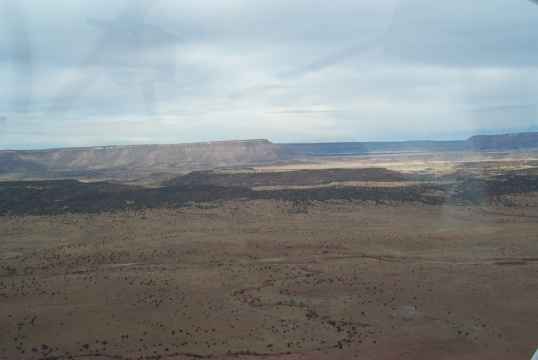The Cibolero Trail
Across the Plains of Eastern New Mexico

Aerial photo looking north across Mesa Montosa, Conchas Ranch, San Miguel County, New Mexico


Aerial photo looking north across Mesa Montosa, Conchas Ranch, San Miguel County, New Mexico

On Eastern New Mexico's grassy plains, for almost two hundred years, the early Mexican settlers developed a cowboy life-style revolving around the buffalo. The Spanish word for buffalo is "cibola." Hence, the cowboys who hunted the buffalo were called "Ciboleros."
In order to provide meat for the families of their villages, the Ciboleros made hunting trips through the valleys and mountains of Eastern New Mexico, following the buffalo over to the Llano Estacado of Western Texas. These hunts usually occurred during October, after the crops had been harvested, and the weather was still mild. Also, the buffalo hides were in prime condition that time of the year.Capturing the buffalo was accomplished at times by trapping them in long, deep trenches where they would use their spear to kill them. Other times they would ride their ponies along side of the buffalo, spearing them "on the run."
Many of the Ciboleros lived along the Pecos River in the small villages of San José, Tecolote, San Miguel, and La Cuesta, now known as Villanueva. They would travel across the plains in a southeasterly direction passing through Chaperito, then to Cabra Springs, La Garita, Montoya, crossing the Gallinas and Conchas Rivers (photo below) and finally reaching the Llano Estacado, near the Texas border. This would take about 10 days,
Josiah Gregg, writing in "The Commerce of the Prairies" in 1844 says this of the Ciboleros:
"As we were proceeding on our march, we observed a horseman approaching, who excited at first considerable curiosity. His picturesque costume, and peculiarity of deportment, however, soon showed him to be a Mexican Cibolero or buffalo-hunter. These hardy devotees of the chase usually wear leathern trousers and jackets, and flat straw hats; while, swung upon the shoulder of each hangs his carcage or quiver of bow and arrows. The long handle of their lance being set in a case, and suspended by the side with a strap from the pommel of the saddle, leaves the point waving high over the head, with a tassel of gay parti-colored stuffs dangling at the tip of the scabbard."The Ciboleros would prepare the buffalos at the camping areas. Nothing would be wasted. From horn to tail, everything would be used. The hide would be stretched out in the sun to dry. The meat was cut into thin slices, salted, and hung to dry. The fat would be rendered in big copper kettles, and the lard would be used to make a kind of soap called jabon de lejía, or lye soap.The weary hunters would be joyously welcomed back at the villages along the Pecos River. A celebration would take place with lots of food and music, and the fruits of the hunt would be divided, to be shared by all the people of the village. There would be enough meat to last for the long winter ahead.
Two smaller photos taken March 1, 2002 for Geodashing trip.
Getting there is all the fun!
GD9-02315 point located at: 35°23' 00"N, 104° 51' 29"W

Send comments, suggestions or inquiries:
Overland Trail
[Overland Trail | Mapping the Trails | Stars Over the Western Trails | Trails West Links ]
Created and maintained by Elizabeth Larson
Copyright © 1996-2002 All Rights Reserved